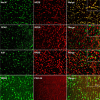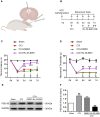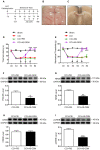PSD-95 in the anterior cingulate cortex contributes to neuropathic pain by interdependent activation with NR2B
- PMID: 36224339
- PMCID: PMC9556829
- DOI: 10.1038/s41598-022-21488-7
PSD-95 in the anterior cingulate cortex contributes to neuropathic pain by interdependent activation with NR2B
Abstract
Studies suggest that the scaffolding protein, postsynaptic density protein-95 (PSD-95), is involved in multiple neurological dysfunctions. However, the role of PSD-95 in the anterior cingulate cortex (ACC) in neuropathic pain (NP) has not been investigated. The current study addressed the role of PSD-95 in the ACC in NP and its modulating profile with NMDA receptor subunit 2B (NR2B). The NP model was established by chronic constriction injury (CCI) of the sciatic nerve, and mechanical and thermal tests were used to evaluate behavioral hyperalgesia. Protein expression and distribution were evaluated using immunohistochemistry and western blotting. The results showed that PSD-95 and NR2B were co-localized in neurons in the ACC. After CCI, both PSD-95 and NR2B were upregulated in the ACC. Inhibiting NR2B with Ro 25-6981 attenuated pain hypersensitivity and decreased the over-expression of PSD-95 induced by CCI. Furthermore, intra-ACC administration of PSD-95 antisense oligonucleotide not only attenuated pain hypersensitivity but also downregulated the NR2B level and the phosphorylation of cyclic AMP response element-binding protein. These results demonstrated that PSD-95 in the ACC contributes to NP by interdependent activation of NR2B.
© 2022. The Author(s).
Conflict of interest statement
The authors declare no competing interests.
Figures






Similar articles
-
PSD-95 Protein: A Promising Therapeutic Target in Chronic Pain.Mol Neurobiol. 2025 Mar;62(3):3361-3375. doi: 10.1007/s12035-024-04485-x. Epub 2024 Sep 16. Mol Neurobiol. 2025. PMID: 39285025 Review.
-
N-methyl D-aspartate receptor subtype 2B antagonist, Ro 25-6981, attenuates neuropathic pain by inhibiting postsynaptic density 95 expression.Sci Rep. 2018 May 18;8(1):7848. doi: 10.1038/s41598-018-26209-7. Sci Rep. 2018. PMID: 29777135 Free PMC article.
-
Perturbing NR2B-PSD-95 interaction relieves neuropathic pain by inactivating CaMKII-CREB signaling.Neuroreport. 2017 Sep 6;28(13):856-863. doi: 10.1097/WNR.0000000000000849. Neuroreport. 2017. PMID: 28746067
-
Caveolin-1 in the anterior cingulate cortex modulates chronic neuropathic pain via regulation of NMDA receptor 2B subunit.J Neurosci. 2015 Jan 7;35(1):36-52. doi: 10.1523/JNEUROSCI.1161-14.2015. J Neurosci. 2015. PMID: 25568101 Free PMC article.
-
Targeting the NMDA receptor subunit NR2B for the treatment of neuropathic pain.Neurotherapeutics. 2009 Oct;6(4):693-702. doi: 10.1016/j.nurt.2009.07.008. Neurotherapeutics. 2009. PMID: 19789073 Free PMC article. Review.
Cited by
-
Cognitive and Affective Dysregulation in Neuropathic Pain: Associated Hippocampal Remodeling and Microglial Activation.Int J Mol Sci. 2025 Jul 4;26(13):6460. doi: 10.3390/ijms26136460. Int J Mol Sci. 2025. PMID: 40650236 Free PMC article.
-
PSD-95 Protein: A Promising Therapeutic Target in Chronic Pain.Mol Neurobiol. 2025 Mar;62(3):3361-3375. doi: 10.1007/s12035-024-04485-x. Epub 2024 Sep 16. Mol Neurobiol. 2025. PMID: 39285025 Review.
-
Recent advances in the study of anesthesia-and analgesia-related mechanisms of S-ketamine.Front Pharmacol. 2023 Sep 14;14:1228895. doi: 10.3389/fphar.2023.1228895. eCollection 2023. Front Pharmacol. 2023. PMID: 37781698 Free PMC article. Review.
References
Publication types
MeSH terms
Substances
LinkOut - more resources
Full Text Sources
Research Materials
Miscellaneous

